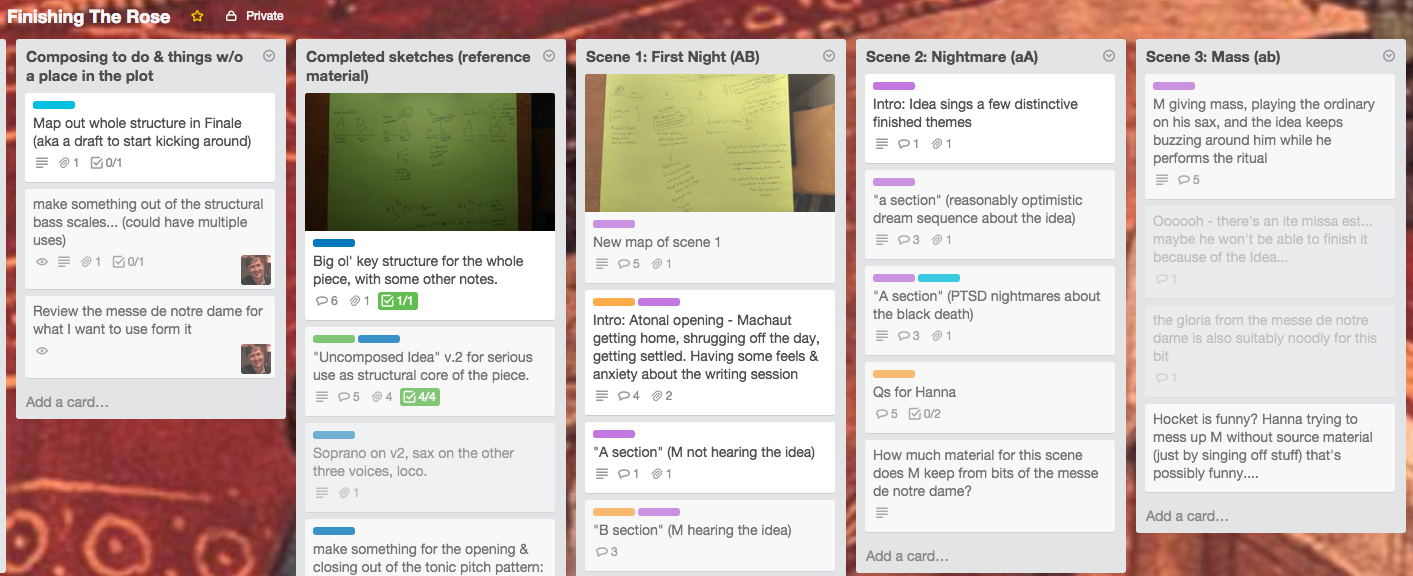I’ve never written a piece using a project management tool before. It’s almost certainly not for everyone, but I totally love it.
The best part is being able to easily sort & rearrange my notes. With a paper notebook, or loose paper, you can’t move individual sentences around. I tend to write out verbal descriptions of what I’m planning, and then as I keep working, I write the same idea out more and more times, but with more and more refinement each time. With a paper notebook, those versions are poorly sorted, far apart from each other, and they’re certainly not labelled. With paper, I’ve just got to remember the best form of a particular idea is.
But with Trello, I can see the ideas laid out, one per card, very easily, and when I have new notes, and better versions of ideas, it’s super easy to make new notes on an idea in the right place. I don’t need to go through all my paper notes anymore to find stuff – as I take notes, they start to take the literal shape of the piece I’m writing. That’s super helpful, and a great time saver.
One of the best perks has been being able to find conflicts in my notes & thinking about sections of the piece. Using a management tool like this makes it really easy to notice these issues, and resolve them. This happens a lot when I’ve written some long comment on one trello card that has implications for a lot of different sections, and then I try to break that large comment out into discrete notes can live on the cards for those sections of the piece. Then I find a conflict in my thinking, in my map of the piece, and I can resolve it while arranging my notes. That’s super helpful.
I’ve also really enjoyed being able to throw up hasty sketches of key thematic sections to send to Ian and Hanna, who are commissioning the piece. The question I ask most is “is this comfortable at this pitch level?”. I ask it more than any other, and I wasn’t expecting it to be so dominant in my collaboration. But here’s the thing, once a bit of thematic material is set in its key, and I start filling in around it with other phrases, it gets stuck there. The more complete the draft gets, the harder it gets to transpose an individual section to make it easier ot sing or play. So really, key is the biggest dependent variable that having musician input earlier is helping with. The result will be a piece that’s more comfortable, easier, and hopefully more fun to play.
The last thing I wanted to mention is that I have a brand new use case for my phone camera. Plenty of times I sketch stuff out on one or two sheets of manuscript paper, and I want to store that sketch without having to bother doing the data entry into Finale. Or I draw a diagram of the sections in the piece to map out some of the dramatic interactions. And so I’ve got a bit of paper that I don’t want to have to keep in the right order. So I take a photo and upload it to the Trello board; all my sketches stay attached to the point in the piece I’m working on. Nothing gets lost, and it’s really easy to see how much of the piece is written, or planned, at any given point. I love it.
Pretty much Im saying that instead of filing a proper commit, I take a photo of a paper sketch. It’s super helpful.
If you want to look at the trello board and follow along, you can join the commissioning consortium for Finishing the Rose right here:

Brilliant! I’ve just started using Trello more to keep track of non-composing work, like the various updates I want to make to my website. Why not use it for composing too? Keeping track of all my scribbles on score paper is good.